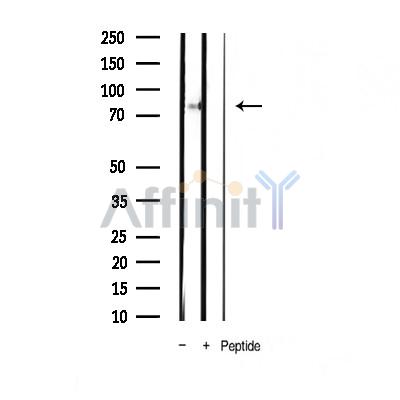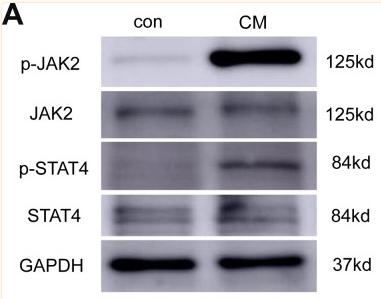Phospho-STAT4 (Tyr693) Antibody - #AF3441
| Product: | Phospho-STAT4 (Tyr693) Antibody |
| Catalog: | AF3441 |
| Description: | Rabbit polyclonal antibody to Phospho-STAT4 (Tyr693) |
| Application: | WB IHC IF/ICC IP |
| Cited expt.: | WB |
| Reactivity: | Human, Mouse, Rat |
| Prediction: | Pig, Horse, Rabbit, Chicken |
| Mol.Wt.: | 86kDa; 86kD(Calculated). |
| Uniprot: | Q14765 |
| RRID: | AB_2834883 |
Product Info
*The optimal dilutions should be determined by the end user. For optimal experimental results, antibody reuse is not recommended.
*Tips:
WB: For western blot detection of denatured protein samples. IHC: For immunohistochemical detection of paraffin sections (IHC-p) or frozen sections (IHC-f) of tissue samples. IF/ICC: For immunofluorescence detection of cell samples. ELISA(peptide): For ELISA detection of antigenic peptide.
Cite Format: Affinity Biosciences Cat# AF3441, RRID:AB_2834883.
Fold/Unfold
Signal transducer and activator of transcription 4; SLEB11; STAT4; STAT4_HUMAN;
Immunogens
A synthesized peptide derived from human STAT4 around the phosphorylation site of Tyr693.
- Q14765 STAT4_HUMAN:
- Protein BLAST With
- NCBI/
- ExPASy/
- Uniprot
MSQWNQVQQLEIKFLEQVDQFYDDNFPMEIRHLLAQWIENQDWEAASNNETMATILLQNLLIQLDEQLGRVSKEKNLLLIHNLKRIRKVLQGKFHGNPMHVAVVISNCLREERRILAAANMPVQGPLEKSLQSSSVSERQRNVEHKVAAIKNSVQMTEQDTKYLEDLQDEFDYRYKTIQTMDQSDKNSAMVNQEVLTLQEMLNSLDFKRKEALSKMTQIIHETDLLMNTMLIEELQDWKRRQQIACIGGPLHNGLDQLQNCFTLLAESLFQLRRQLEKLEEQSTKMTYEGDPIPMQRTHMLERVTFLIYNLFKNSFVVERQPCMPTHPQRPLVLKTLIQFTVKLRLLIKLPELNYQVKVKASIDKNVSTLSNRRFVLCGTNVKAMSIEESSNGSLSVEFRHLQPKEMKSSAGGKGNEGCHMVTEELHSITFETQICLYGLTIDLETSSLPVVMISNVSQLPNAWASIIWYNVSTNDSQNLVFFNNPPPATLSQLLEVMSWQFSSYVGRGLNSDQLHMLAEKLTVQSSYSDGHLTWAKFCKEHLPGKSFTFWTWLEAILDLIKKHILPLWIDGYVMGFVSKEKERLLLKDKMPGTFLLRFSESHLGGITFTWVDHSESGEVRFHSVEPYNKGRLSALPFADILRDYKVIMAENIPENPLKYLYPDIPKDKAFGKHYSSQPCEVSRPTERGDKGYVPSVFIPISTIRSDSTEPHSPSDLLPMSPSVYAVLRENLSPTTIETAMKSPYSAE
Predictions
Score>80(red) has high confidence and is suggested to be used for WB detection. *The prediction model is mainly based on the alignment of immunogen sequences, the results are for reference only, not as the basis of quality assurance.
High(score>80) Medium(80>score>50) Low(score<50) No confidence
Research Backgrounds
Carries out a dual function: signal transduction and activation of transcription. Involved in IL12 signaling.
Tyrosine phosphorylated. Serine phosphorylation is also required for maximal transcriptional activity (By similarity).
Cytoplasm. Nucleus.
Note: Translocated into the nucleus in response to phosphorylation.
Belongs to the transcription factor STAT family.
Research Fields
· Cellular Processes > Cell growth and death > Necroptosis. (View pathway)
· Environmental Information Processing > Signal transduction > Jak-STAT signaling pathway. (View pathway)
· Human Diseases > Infectious diseases: Viral > Hepatitis B.
· Human Diseases > Cancers: Overview > Pathways in cancer. (View pathway)
· Human Diseases > Immune diseases > Inflammatory bowel disease (IBD).
· Organismal Systems > Immune system > Th1 and Th2 cell differentiation. (View pathway)
References
Application: WB Species: Rat Sample: fibroblasts
Restrictive clause
Affinity Biosciences tests all products strictly. Citations are provided as a resource for additional applications that have not been validated by Affinity Biosciences. Please choose the appropriate format for each application and consult Materials and Methods sections for additional details about the use of any product in these publications.
For Research Use Only.
Not for use in diagnostic or therapeutic procedures. Not for resale. Not for distribution without written consent. Affinity Biosciences will not be held responsible for patent infringement or other violations that may occur with the use of our products. Affinity Biosciences, Affinity Biosciences Logo and all other trademarks are the property of Affinity Biosciences LTD.



